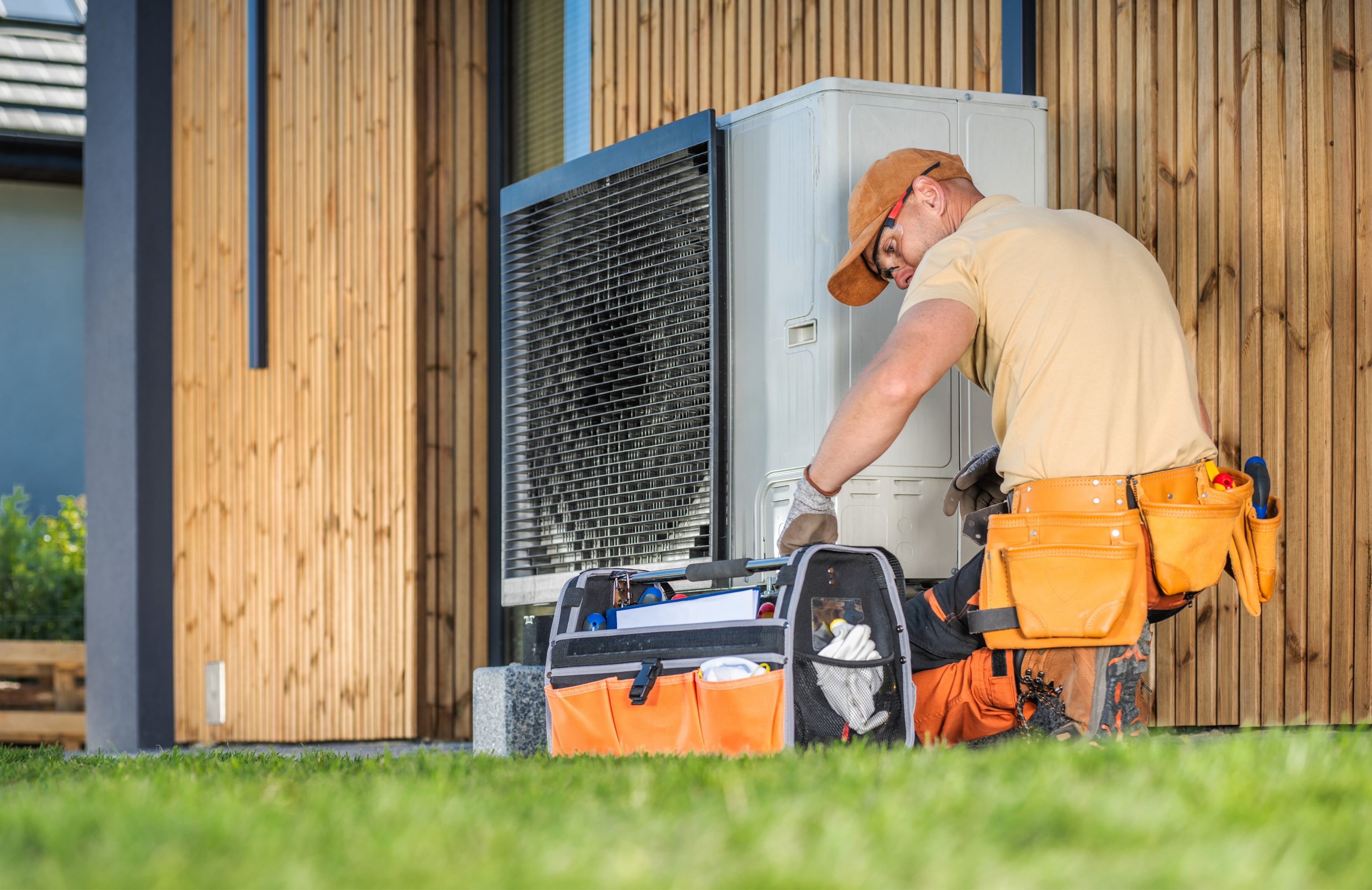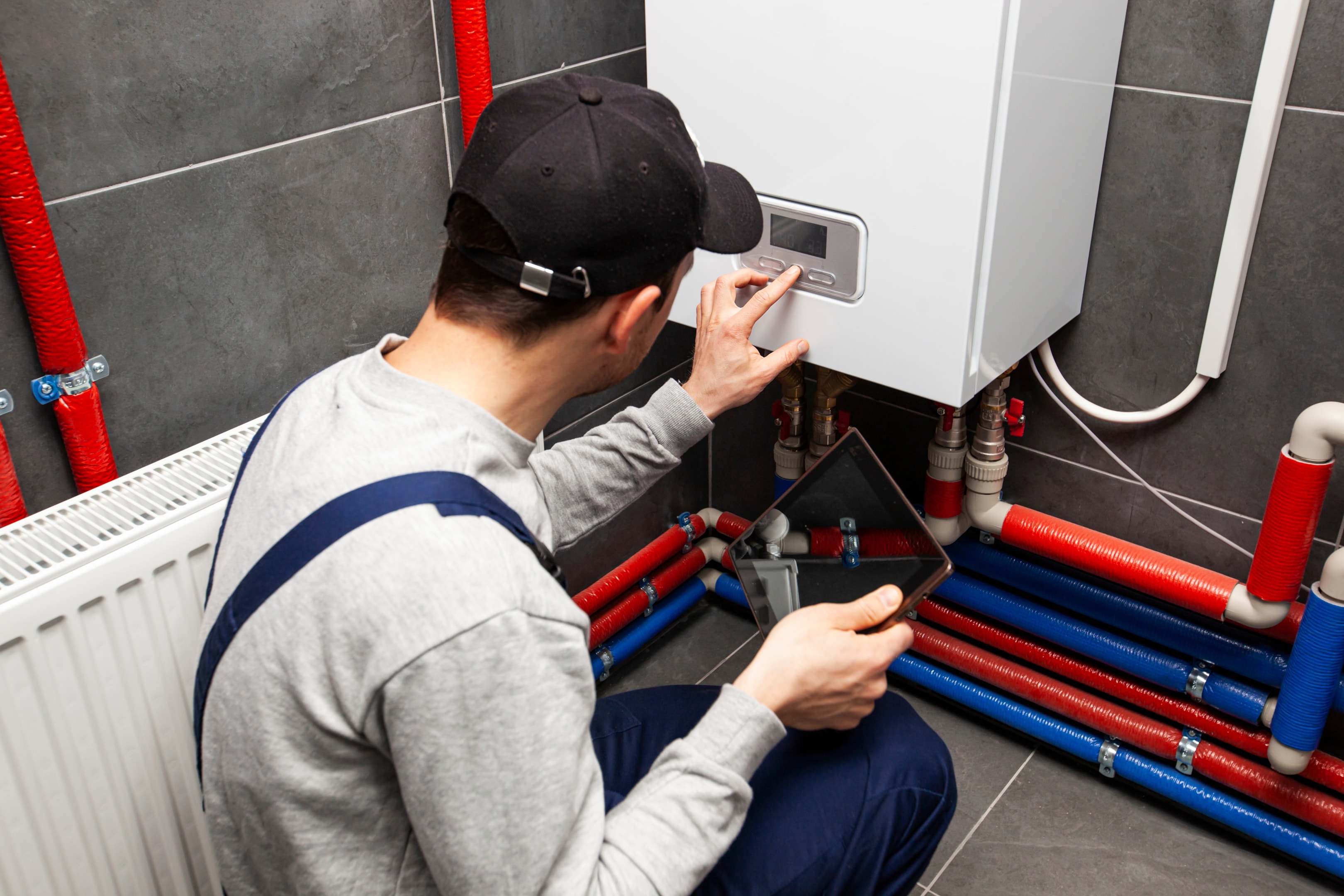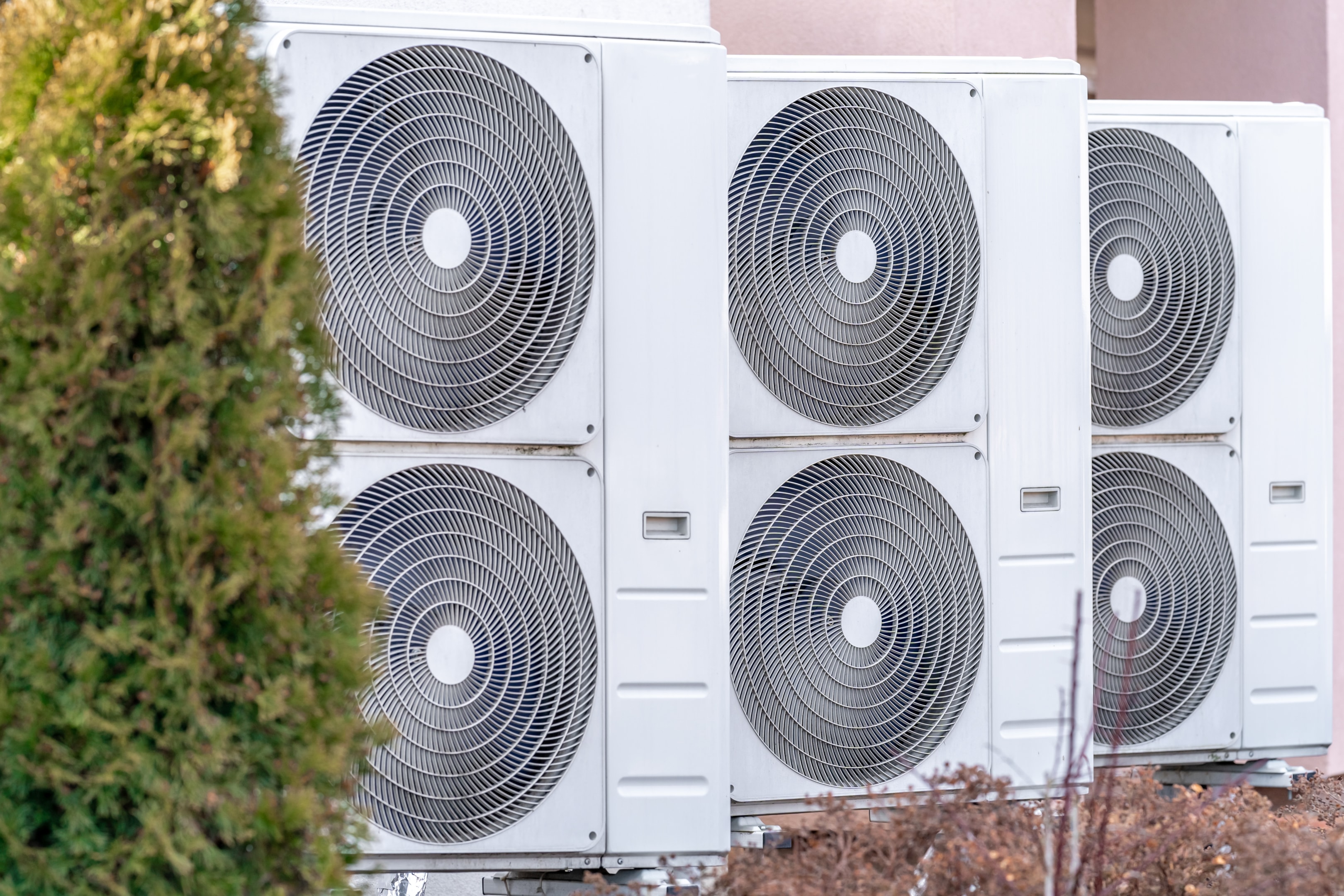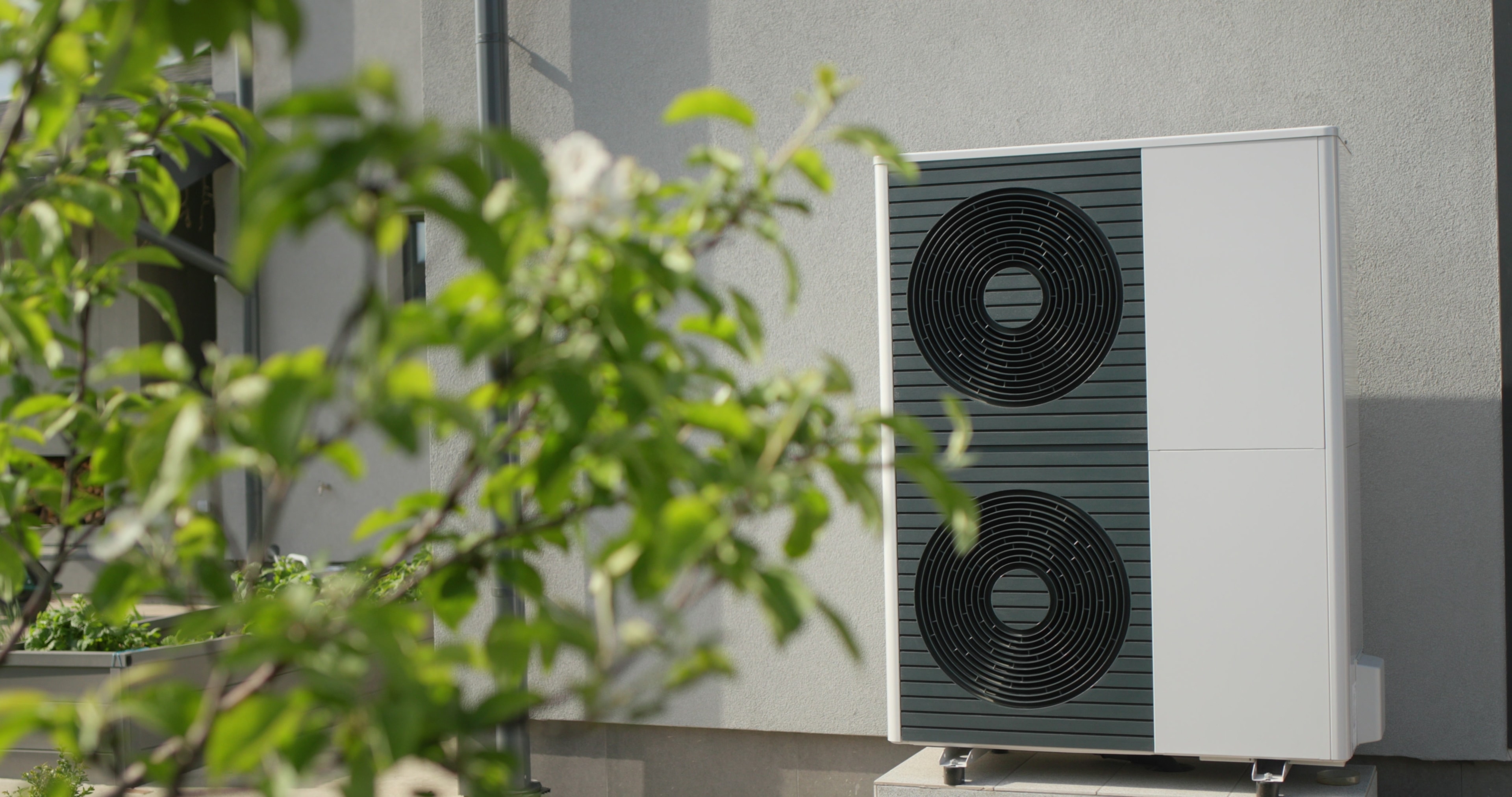Is your heat pump disrupting your peace of mind? Discover effective heat pump noise control methods here. This article covers how to minimise noise through proper installation, regular maintenance, and the use of acoustic enclosures. The MCS certification process requires a Sound Power Level test to ensure compliance with sound level requirements for heat pumps, making it a critical step in noise management.
Key Takeaways
- Heat pump noise primarily comes from the external fan and compressor, with strategic installation helping to minimise disturbances.
- Proper maintenance and installation techniques, such as using solid foundations and vibration isolation, can significantly reduce noise levels.
- Compliance with local noise regulations is crucial to avoid legal issues and ensure that heat pumps operate within acceptable sound limits. Many manufacturers now offer noise-reducing heat pump models designed specifically for quiet operation. Choosing a quieter heat pump model can help prevent potential noise complaints from neighbours.
Understanding Heat Pump Noise

The primary noise sources in air-source heat pumps are the external fan and the compressor. While the compressor generates less noise compared to the external fan, the latter is the most significant contributor to the overall sound from heat pumps. Ground-source heat pumps, on the other hand, are quieter as they lack an external fan.
Typically, air source heat pumps operate at noise levels between 40 and 60 decibels, comparable to the sound of a normal conversation or background music. A heat pump with an outdoor unit can make around 40 to 50 decibels of noise when operating at full speed. An ASHP typically produces around 60dB of sound during operation. The location of the heat pump unit plays a crucial role in the perceived noise level. Installing the unit in a strategic location can significantly reduce the impact of noise on living spaces, enhancing heat pump efficiency.
Common Noise Complaints and Their Causes
One of the most frequent noise complaints associated with heat pumps is the presence of low-frequency tones, often described as a humming sound. These tones can be particularly disturbing during the night when the ambient noise levels are lower. A newly installed air-source heat pump can create noise complaints from neighbours if it produces low-frequency sound. Improper installation practices can exacerbate these issues, leading to increased sound levels and more complaints from users. The majority of noise reports on heat pump noise are inadequate due to the omission of tonal analysis, which is crucial for accurate diagnosis and resolution. Normal noise control measures like barriers, acoustic enclosures, and silencers can be ineffective at low frequencies, making specialised solutions necessary.
Seasonal variations can also affect heat pump noise. During colder months, the system might produce additional sounds due to the higher workload required to maintain indoor temperatures. Environmental factors, such as outdoor temperature and sound reflections, can amplify certain frequencies, making the source heat pump noise more noticeable.
Amplified noise levels, particularly at specific frequencies like a 93Hz pumping frequency, can be a significant cause of concern for homeowners. Understanding these common causes can help in addressing the noise-produced issues effectively and ensuring a quieter operation of your heat pump. Diagnosing heat pump noise requires identifying the four major noise sources for effective reduction. A narrow-band frequency analysis is essential for diagnosing heat pump noise issues, as it provides a detailed understanding of the specific frequencies contributing to the problem.
Proper Installation Techniques for Noise Reduction
Proper installation of heat pumps is crucial for minimising noise. Installing the heat pump on a solid foundation can significantly decrease vibrations that lead to noise. Additionally, placing the unit away from bedrooms and living spaces helps to reduce noise disturbance indoors.
Thoughtful design and strategic installation can greatly mitigate noise levels from air-source heat pumps. Consideration of the location and foundation allows homeowners to enjoy the benefits of a heat pump with heat pumps installed without the accompanying noise nuisance.
Regular Maintenance to Keep Your Heat Pump Quiet

Regular maintenance keeps your heat pump quiet and efficient. Over time, components can wear and deteriorate, leading to increased noise levels. Tasks such as cleaning or replacing filters, tightening loose screws and panels can help keep noise to a minimum. Additionally, low-cost aerodynamic fan modifications can reduce low-frequency tonal heat pump fan noise by more than 90%, offering a cost-effective solution for quieter operation.
Clearing debris from around the outdoor unit is another important maintenance task that can prevent grinding or clanking sounds. Regular professional inspections are crucial for addressing mechanical issues that cause persistent noise, ensuring that your heat pump operates quietly and efficiently.
Staying on top of regular maintenance prevents the constant hum and other noises from being heard as a nuisance while improving overall energy efficiency and speed, making the system work harder and run louder, and allowing you to switch to a more efficient operation, ultimately reducing your energy bills through technology, and preventing it from becoming noisier.
Acoustic Enclosures for Heat Pumps

Acoustic enclosures are structures designed to contain and reduce noise from heat pumps by trapping sound within their walls. These enclosures use a combination of soundproofing materials, including highly absorbent acoustic mineral wool and a steel frame, to effectively dampen noise levels.
Using an acoustic enclosure can reduce the noise emitted by heat pumps by as much as 32 decibels, making it a cost-effective solution for noise reduction. These enclosures are particularly recommended for air-source heat pumps and can be installed retrospectively without compromising the unit’s functionality.
Choosing the Right Acoustic Enclosure
When selecting an acoustic enclosure, it’s essential to consider the materials used, as they impact the level of noise reduction. Options include:
- Galvanised steel
- Coated steel
- Wood clad. Each offers different levels of soundproofing. Consulting soundproofing experts can ensure that you choose the correct size and configuration for your specific heat pump needs.
Customisation options are available for acoustic enclosures to meet location and access needs. For example, an acoustic fence can be designed to blend with outdoor spaces by matching a garden or supporting climbing plants. Engaging an expert ensures the best soundproofing performance and a seamless integration with your surroundings.
Installation Tips for Acoustic Enclosures
The installation of acoustic enclosures should ensure an airtight fit to maximise noise reduction effectiveness. This involves careful attention to detail during the installation process to ensure that all gaps are sealed and the enclosure is securely fitted around the heat pump.
Vibration Isolation Techniques
Implementing vibration isolation techniques can significantly reduce heat pump noise by minimising the vibrations transferred to surrounding structures. Anti-vibration mounts or pads can lessen the vibration transfer from the heat pump to the building, cutting noise by approximately 15 dB. Compressor and pump noise in heat pumps is caused by structure-borne vibration radiating as sound, making vibration isolation a critical component of noise reduction.
High-efficiency damping on surfaces that radiate sounds, such as pumps and compressors, can also effectively minimise vibration-related noise. It’s crucial to ensure that these methods do not create short circuits in connections between high-vibration pipes and the frame.
Using rubber feet and placing the unit on the ground instead of mounting it on a wall can also help reduce noise.
Soundproofing Solutions for Heat Pumps

Constructing barriers, such as walls or fences, around the heat pump can help to deflect sound waves before they reach living areas. Enhancing insulation and sealing ductwork can further minimise sound transmission throughout the home.
Soundproofing wraps or blankets can be used on heat pump compressors to absorb and deflect sound waves, further reducing noise levels. DIY solutions, like building a wooden enclosure lined with insulation, can also be effective in reducing heat pump noise.
Assessing Heat Pump Noise Levels
Legal noise regulations in the UK require that air source heat pumps do not exceed 42 decibels when measured from neighbouring properties. In the UK, heat pumps installed from 1 April 2021 onwards must not exceed 40 decibels from the property boundary during nighttime hours. This noise level is comparable to the sound of a running refrigerator, indicating that it should be unobtrusive.
A noise assessment for heat pumps measures sound output at one metre away from the unit to ensure compliance with legal limits. Understanding how loud 42 decibels is in comparison to common household sounds, like a running laptop, helps put these sound level regulations into perspective regarding decibel levels.
Ensuring Compliance with Noise Regulations
Ensuring compliance with noise regulations is crucial to minimise inconvenience to neighbours and avoid potential legal issues. The maximum allowable noise level for a heat pump during the day is 45 decibels, while it must not exceed 42 decibels at night to avoid being considered a nuisance.
Conducting a noise assessment before installing a heat pump is advisable to ensure compliance with local regulations. Key points to consider include:
- If noise levels exceed permitted limits, implement noise mitigation methods to achieve compliance.
- Be aware of applicable EU regulations (No. 813/2013).
- Stay informed about upcoming changes effective May 2025 for proper noise assessment.
New regulations effective May 2025 will alter how noise from air source heat pumps is assessed, following an independent review. Homeowners must stay informed and take note of these changes to ensure compliance and avoid future complaints.
Managing Noise Impact on Neighbours
Minimising the noise impact on neighbours involves installing air source heat pumps at least one meter away from the property boundary. Positioning the heat pump away from bedrooms and shared walls significantly reduces perceived noise levels. Heat pumps should not be installed closer than 1 meter to the boundary line in the UK to minimise noise disturbances. Improperly installed units can lead to complaints and unnecessary expenses due to noise regulation issues, making proper planning and installation essential.
To manage noise effectively during heat pump installation:
- Engage a noise consultant during the planning phase to assess site conditions for optimal placement.
- Install sound insulation and barriers to reduce noise levels travelling to neighbouring properties.
- Inform neighbours about the heat pump installation to prevent disputes and ensure transparency.
Consulting local authorities about noise regulations is essential to avoid future complaints from neighbours. Educating the unhappy neighbour about the benefits of heat pumps and the noise control measures implemented can help alleviate concerns and foster a more understanding community. This is a comprehensive guide to addressing these issues effectively.
Summary
Reducing heat pump noise involves a combination of proper installation, regular maintenance, and effective soundproofing solutions. By understanding the common sources and causes of noise, homeowners can implement strategies to minimise disturbances and maintain a peaceful living environment.
In conclusion, taking proactive steps to manage heat pump noise ensures comfort and compliance with regulations. Embrace these solutions to enjoy the benefits of a heat pump without compromising on tranquillity. Your home should be a haven of peace, and with these tips, it can be.
Frequently Asked Questions
What are the primary sources of noise in air-source heat pumps?
The primary sources of noise in air-source heat pumps are the external fan and the compressor, with the external fan being the most significant contributor. Understanding these sources can help in selecting quieter models or implementing sound-dampening measures if noise is a concern. Most heat pump noise specifications are based solely on overall broadband dB(A) levels, which may not fully capture the impact of specific noise frequencies.
How can I reduce the noise from my heat pump?
To effectively reduce noise from your heat pump, focus on proper installation and regular maintenance, and consider using acoustic enclosures and vibration isolation techniques. Soundproofing solutions can also significantly minimise disturbances. Proper installation and maintenance are the most effective methods to reduce heat pump noise, ensuring both compliance with regulations and a quieter living environment.
What is the legal noise limit for heat pumps in the UK?
The legal noise limit for heat pumps in the UK is 42 decibels when measured from neighbouring properties. Compliance with this standard is essential to avoid disturbances to your neighbours. During the daytime, UK heat pumps can produce a maximum noise level of 45 decibels at the property boundary, highlighting the importance of adhering to these regulations. In the UK, the legal limit for an air source heat pump is 42 decibels when measured from the nearest property, ensuring minimal impact on surrounding areas.
How do acoustic enclosures work?
Acoustic enclosures effectively trap sound by utilising soundproofing materials, such as acoustic mineral wool, within steel-framed structures, resulting in significantly reduced noise levels. Acoustic enclosures can be installed retrospectively around an existing ASHP. This design ensures a quieter environment by minimising sound transmission.
Why is regular maintenance important for keeping heat pumps quiet?
Regular maintenance is essential for keeping heat pumps quiet, as it addresses wear and mechanical issues that may lead to increased noise. By regularly cleaning filters, tightening screws, and clearing debris, you can ensure optimal performance and minimise sound levels.

Add comment